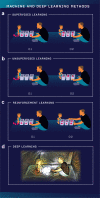A short guide for medical professionals in the era of artificial intelligence
- PMID: 33043150
- PMCID: PMC7518439
- DOI: 10.1038/s41746-020-00333-z
A short guide for medical professionals in the era of artificial intelligence
Abstract
Artificial intelligence (A.I.) is expected to significantly influence the practice of medicine and the delivery of healthcare in the near future. While there are only a handful of practical examples for its medical use with enough evidence, hype and attention around the topic are significant. There are so many papers, conference talks, misleading news headlines and study interpretations that a short and visual guide any medical professional can refer back to in their professional life might be useful. For this, it is critical that physicians understand the basics of the technology so they can see beyond the hype, evaluate A.I.-based studies and clinical validation; as well as acknowledge the limitations and opportunities of A.I. This paper aims to serve as a short, visual and digestible repository of information and details every physician might need to know in the age of A.I. We describe the simple definition of A.I., its levels, its methods, the differences between the methods with medical examples, the potential benefits, dangers, challenges of A.I., as well as attempt to provide a futuristic vision about using it in an everyday medical practice.
Keywords: Communication; Information technology; Medical research.
© The Author(s) 2020.
Conflict of interest statement
Competing interestsThe authors declare no competing interests.
Figures



Similar articles
-
The future of Cochrane Neonatal.Early Hum Dev. 2020 Nov;150:105191. doi: 10.1016/j.earlhumdev.2020.105191. Epub 2020 Sep 12. Early Hum Dev. 2020. PMID: 33036834
-
Implementing the 2009 Institute of Medicine recommendations on resident physician work hours, supervision, and safety.Nat Sci Sleep. 2011 Jun 24;3:47-85. doi: 10.2147/NSS.S19649. Print 2011. Nat Sci Sleep. 2011. PMID: 23616719 Free PMC article.
-
How has the impact of 'care pathway technologies' on service integration in stroke care been measured and what is the strength of the evidence to support their effectiveness in this respect?Int J Evid Based Healthc. 2008 Mar;6(1):78-110. doi: 10.1111/j.1744-1609.2007.00098.x. Int J Evid Based Healthc. 2008. PMID: 21631815
-
ARTIFICIAL INTELLIGENCE IN MEDICAL PRACTICE: REGULATIVE ISSUES AND PERSPECTIVES.Wiad Lek. 2020;73(12 cz 2):2722-2727. Wiad Lek. 2020. PMID: 33611272 Review.
-
New and emerging technology for adult social care - the example of home sensors with artificial intelligence (AI) technology.Health Soc Care Deliv Res. 2023 Jun;11(9):1-64. doi: 10.3310/HRYW4281. Health Soc Care Deliv Res. 2023. PMID: 37470136
Cited by
-
Ethicara for Responsible AI in Healthcare: A System for Bias Detection and AI Risk Management.AMIA Annu Symp Proc. 2024 Oct 21;2023:2023-2032. eCollection 2023. AMIA Annu Symp Proc. 2024. PMID: 39435256 Free PMC article.
-
New horizons in prediction modelling using machine learning in older people's healthcare research.Age Ageing. 2024 Sep 1;53(9):afae201. doi: 10.1093/ageing/afae201. Age Ageing. 2024. PMID: 39311424 Free PMC article.
-
The past, current, and future of neonatal intensive care units with artificial intelligence: a systematic review.NPJ Digit Med. 2023 Nov 27;6(1):220. doi: 10.1038/s41746-023-00941-5. NPJ Digit Med. 2023. PMID: 38012349 Free PMC article. Review.
-
Future Medical Artificial Intelligence Application Requirements and Expectations of Physicians in German University Hospitals: Web-Based Survey.J Med Internet Res. 2021 Mar 5;23(3):e26646. doi: 10.2196/26646. J Med Internet Res. 2021. PMID: 33666563 Free PMC article.
-
Healthcare students' knowledge, attitudes, and perspectives toward artificial intelligence in the southern Vietnam.Heliyon. 2023 Nov 22;9(12):e22653. doi: 10.1016/j.heliyon.2023.e22653. eCollection 2023 Dec. Heliyon. 2023. PMID: 38107295 Free PMC article.
References
-
- Russell, S. & Norvig, P. Artificial intelligence a modern approach third edition (Pearson, 2010).
-
- Bostrom, N. Superintelligence: paths, dangers, strategies. http://ovidsp.ovid.com/ovidweb.cgi?T=JS&PAGE=reference&D=psyc11&NEWS=N&A... (2014).
Publication types
LinkOut - more resources
Full Text Sources

